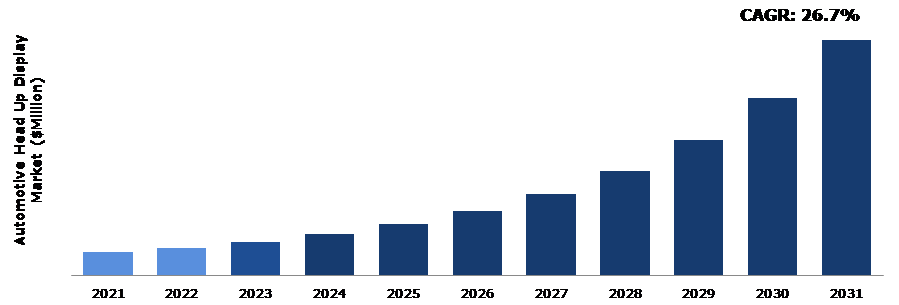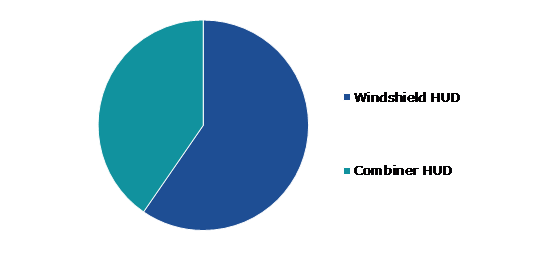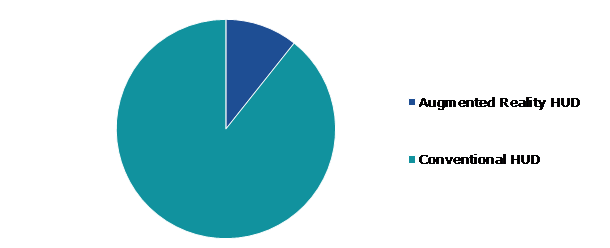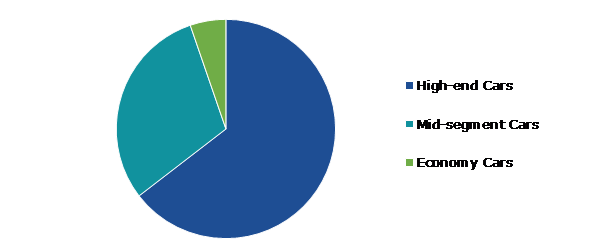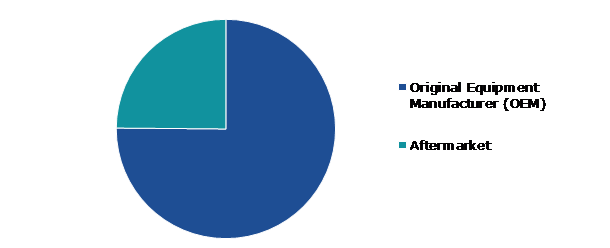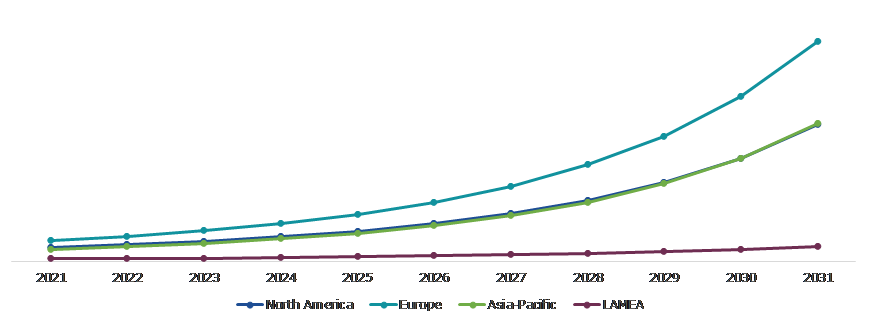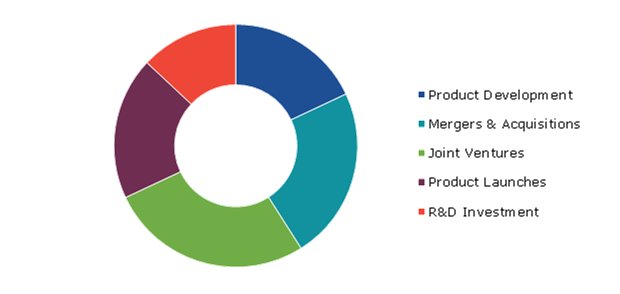Automotive Head Up Display Market Report
RA03086
Automotive Head Up Display Market by HUD Type (Windshield HUD and Combiner HUD), Technology (Augmented Reality HUD and Conventional HUD), Car Type (High-end Cars, Mid-segment Cars, and Economy Cars), Sales Channel (Original Equipment Manufacturer (OEM) and Aftermarket), and Regional Analysis (North America, Europe, Asia-Pacific, and LAMEA): Global Opportunity Analysis and Industry Forecast, 2022–2031
Global Automotive Head Up Display Market Analysis
The Global Automotive Head Up Display Market Size was $1,024.0 million in 2021 and is predicted to grow with a CAGR of 26.7%, by generating a revenue of $10,382.1 million by 2031.
Global Automotive Head Up Display Market Synopsis
The increasing demand for vehicles with advanced safety features, rising awareness about road safety among drivers, and growing demand for better in-car experience are some of the major factors driving the growth of the automotive head up display market during the forecast period. Automotive head up displays in cars enhances the in-car experience and road safety by providing drivers with various critical information such as lane departure warnings, routes, ADAS info, traffic warning, speed limit, pedestrian alerts, and others. Low visibility in the rainy and winter season is one of the major issues leading to accidents. This issue is also prevalent in places impacted by heavy ice falls. To overcome these challenges, automotive head up displays can be used, as with the aid of HUD drivers get important information such as turns, curves, direction, and others on the screen itself without eyesight distraction.
The high cost of automotive head up displays along with less awareness about technology in developing countries is predicted to impede market growth during the forecast period. Automotive head up display is a new technology, therefore, there is less awareness in many regions across the world. This technology has improved significantly in the last several years, but there are still some constraints. Images displayed through head up displays may block vital visual information in the real world if head up displays are not designed well. All these factors are expected to limit the automotive head up display market growth during the forecast timeframe.
The rising adoption of automotive head up displays in high-end cars is expected to offer lucrative opportunities for the key players operating in the market. Head up display in the car is a costly option, hence, mostly offered by luxury car brands in their high-end cars. Also, the implementation of HUDs in mid-range cars owing to safety regulations implemented by governments of various countries across the world is expected to drive the automotive head up display market size expansion during the forecast period.
According to regional analysis, the Europe automotive head up display market accounted for the largest market share in 2021, owing to continued R&D in head up display technology, the presence of major automakers, and high sales of luxury cars in this region. Moreover, the growing demand for better safety and in-car experience features among consumers is augmenting the automotive head up display market growth in this region.
Automotive Head Up Display Market Overview
An automotive head up display is a partially transparent display that displays important information such as vehicle speed, direction, turns, and others in a way that helps the driver to understand it without any distraction. Head up displays have also been increasingly used in the aircraft sector in recent years. Their adoption in the automotive sector has increased significantly to increase the safety and in-car experience of drivers and passengers. Currently, several automakers and OEMs are increasing their focus on the development of advanced augmented reality (AR) head up displays. This technology is expected to offer real-time information on the objects on the road.
COVID-19 Impact on Automotive Head Up Display Market
The COVID-19 pandemic has negatively impacted the automotive head up display market growth. Nationwide lockdowns and economic downturns limited the manufacturing of displays. The year 2020 witnessed the slowdown or complete shutdown of many manufacturing units due to labor shortages, supply chain disruptions, and high prices of raw materials. During the pandemic, the automotive industry was among those that witnessed the most significant impact. The decline in mid-segment and economy car sales across the world led to losses in the revenue of automakers. This, in turn, declined or delayed the R&D investment in head up displays. Vehicle sales across Asia-Pacific are the most significant compared to all other regions owing to the rise in population and disposable income. However, the sales of vehicles in this region dropped sharply due to severe COVID-19 transmission during the pandemic. Owing to all these factors, the automotive head up display market share also experienced a negative impact during the pandemic period.
Growth in Automobile Sales Post-COVID-19 along with the Increase in Demand for Safety Features in Vehicles is Anticipated to Drive the Market Growth
Post-COVID-19, vehicle sales of various categories increased significantly owing to the ease of lockdowns and improved availability of semiconductors which is helping vehicle manufacturers to increase productivity and deliver more vehicles. This, in turn, is expected to boost the demand for automotive head up displays. Currently, consumers are highly enthusiastic to get advanced safety and in-car experience, owing to which there is an increase in the popularity of cutting-edge technologies such as automotive head up displays among consumers. The increase in expenses on premium car services for safety is predicted to further supplement the demand for automotive head up displays and drive the automotive head up display market growth during the forecast period.
To know more about global automotive head up display market drivers, get in touch with our analysts here.
High Cost of HUDs is Likely to Restrain Automotive Head Up Display Market Growth
The automotive head-up display system is expensive and more complicated to install. Currently, the head up displays are mostly installed in high-end cars and at a very lower rate in mid and low-end cars due to their high cost. In developing countries, the demand for vehicles is often high for mid and low-price ranges cars. Due to this factor, the demand for advanced technologies such as head up displays is low in developing countries. This is one of the major factors predicted to hamper the automotive head up display market share during the forecast years.
Augmented Reality (AR) Head Up Display to offer Excellent Growth Opportunities in the Upcoming Years
The conventional head up displays come with a small display size and basic features. The projected graphics are located 2 to 3 m in front of the driver, which sets the graphics near the vehicle's front bumper. In addition, their small field of view (FOV) limits the way important information can be projected effectively. These displays do not take the assistance of sensor data to build real-time human-machine interfaces (HMIs). Owing to all these factors, there has been an increase in focus by automakers on AR head up displays. AR displays are able to project images that can interact with the FOV, overlaying information directly onto the real world. This, in turn, is expected to increase the capabilities of head up displays which may boost their adoption in the upcoming years. These are the factor anticipated to create several growth automotive head up display market opportunities for the key players operating in the automotive head up display market during the forecast period.
To know more about global automotive head up display market opportunities, get in touch with our analysts here.
Global Automotive Head Up Display Market, by HUD Type
Based on HUD type, the market is further divided into windshield HUD and combiner HUD. Among these, the windshield HUD sub-segment accounted for the largest market share in 2021.
Global Automotive Head Up Display Market Size, by HUD Type, 2021
Source: Research Dive Analysis
The windshield HUD sub-segment dominated the global automotive head up display market in 2021. Windshield HUDs project images onto the interior of the vehicle's windshield, helping the driver to understand the essential information on the windshield without any distraction. This system does not require any additional combiner and produces information via virtual images directly on the screen of the windshield. The significant demand for windshield HUDs can be attributed to their various advantages such as more security, efficiency, cost-effectiveness, and increases driver's attention toward the road. While designing windshield HUDs, OEMs set extreme priority on assuring that the user sees a distortion-free image directly within the FOV. These are the factors expected to drive the sub-segment automotive head up display market growth during the forecast period.
Global Automotive Head Up Display Market, by Technology
Based on technology, the global automotive head up display market has been divided into augmented reality HUD and conventional HUD. Among these, the augmented reality HUD sub-segment is anticipated to show the fastest CAGR during the forecast period.
Global Automotive Head Up Display Market Share, by Technology, 2021
Source: Research Dive Analysis
The augmented reality HUD sub-segment is expected to witness the fastest growth during the forecast period. Augmented reality (AR) HUDs have a promising future for creating a better in-car experience and increasing the safety of the driver. This system augments real-world objects and greatly improves drivers’ situational awareness. The AR HUDs utilize the power of artificial intelligence (AI) to highlight pedestrians, possible collisions, and crosswalks. It also projects objects in the road, lane edges, and other critical information to drivers within FOV. Currently, AR HUDs are in a rapid growth phase and are expected to be commercialized tremendously in the upcoming years.
Global Automotive Head Up Display Market, by Car Type
Based on car type, the global automotive head up display market has been divided into high-end cars, mid-segment cars, and economy cars. Among these, the high-end cars sub-segment accounted for the largest market share in 2021.
Global Automotive Head Up Display Market Trends, by Car Type, 2021
Source: Research Dive Analysis
The high-end cars sub-segment dominated the market in 2021. Head up displays can be installed in any type of vehicle; however, their demand is high in high-end cars due to their high cost. Many high-end car models of Bentley, Cadillac, BMW, Land Rover, and Rolls-Royce offer a HUD. Other luxury automakers such as Genesis, Buick, Lincoln, Lexus, Audi, Volvo, and Mercedes-Benz, offer a HUD in their premium and high-end cars.
Global Automotive Head Up Display Market, by Sales Channel
Based on sales channel, the global automotive head up display market has been divided into original equipment manufacturer (OEM) and aftermarket. Among these, the original equipment manufacturer (OEM) sub-segment accounted for the largest market share in 2021 and is anticipated to remain dominant during the forecast period.
Global Automotive Head Up Display Market Growth, by Sales Channel, 2021
Source: Research Dive Analysis
The Original Equipment Manufacturer (OEM) sub-segment dominated the market in 2021. Automotive HUDs can be installed into a car either by original equipment manufacturers (OEMs) during the production of the vehicle or can be fitted aftermarket. Every OEM's product varies by technology, dimension type, vehicle type, sales channel, and others. All prominent automotive OEMs are developing HUD technologies that characterize the next generation of infotainment in vehicles. Manufacturing large quantities of HUDs will allow automotive manufacturers to increase performance and decrease costs.
Global Automotive Head Up Display Market, Regional Insights
The automotive head up display market was investigated across North America, Europe, Asia-Pacific, and LAMEA.
Global Automotive Head Up Display Market Size & Forecast, by Region, 2021-2031 ($ Million)
Source: Research Dive Analysis
Europe Dominated the Automotive Head Up Display Market
The Europe region dominated the global automotive head up display market in 2021. The main factors attributed to the substantial growth of the automotive head up display market across this region are the presence of major OEMs, an increase in R&D activities, a rise in disposable income as well as a surge in demand for high-end cars. Another significant factor that is propelling the growth of the market in Europe is the increase in the inclination of consumers in acquiring better in-car experience and safety features.
Global Automotive Head Up Display Market Competitive Scenario
Joint ventures, investment, merger & acquisition, product development, and technological development are the common strategies followed by major automotive head up display market players. For instance, in 2021, WayRay AG and Karma Automotive declare a partnership to install AR Head-Up Display (HUD) technology in a future Karma vehicle.
Source: Research Dive Analysis
Some of the leading players in the automotive head up display market are Continental Valeo, 3M, Hudway, Nippon Seiki Co., Ltd., Denso, Visteon Corporation, Bosch, UniMax, and FIC Group.
| Aspect | Particulars |
| Historical Market Estimations | 2020 |
| Base Year for Market Estimation | 2021 |
| Forecast timeline for Market Projection | 2022-2031 |
| Geographical Scope | North America, Europe, Asia-Pacific, and LAMEA |
| Segmentation by HUD Type |
|
| Segmentation by Technology
|
|
| Segmentation by Car Type |
|
| Segmentation by Sales Channel |
|
| Key Companies Profiled |
|
Q1. What is the size of the automotive head up display market?
A. The global automotive head up display market size was over $1,024.0 million in 2021 ¬-and is anticipated to reach $10,382.1 million by 2031.
Q2. Which are the leading companies in the automotive head up display market?
A. Valeo, Continental, and Visteon Corporation are some of the key players in the global automotive head up display market.
Q3. Which region possesses greater investment opportunities in the future?
A. Asia-Pacific possesses great investment opportunities for investors in the coming years.
Q4. What is the growth rate of the Asia-Pacific market?
A. The Asia-Pacific automotive head up display market is anticipated to grow at 27.8% CAGR during the forecast period.
Q5. What are the strategies opted by the leading players in this market?
A. Product innovations, business expansions, and technological advancements are the key strategies opted by the operating companies in this market.
Q6. Which companies are investing more on R&D practices?
A. Bosch, UniMax, and FIC Group are investing more on R&D activities for developing new products and technologies.
1.Research Methodology
1.1.Desk Research
1.2.Real time insights and validation
1.3.Forecast model
1.4.Assumptions and forecast parameters
1.5.Market size estimation
1.5.1.Top-down approach
1.5.2.Bottom-up approach
2.Report Scope
2.1.Market definition
2.2.Key objectives of the study
2.3.Report overview
2.4.Market segmentation
2.5.Overview of the impact of COVID-19 on Global automotive head up display market
3.Executive Summary
4.Market Overview
4.1.Introduction
4.2.Growth impact forces
4.2.1.Drivers
4.2.2.Restraints
4.2.3.Opportunities
4.3.Market value chain analysis
4.3.1.List of raw material suppliers
4.3.2.List of manufacturers
4.3.3.List of distributors
4.4.Innovation & sustainability matrices
4.4.1.Technology matrix
4.4.2.Regulatory matrix
4.5.Porter’s five forces analysis
4.5.1.Bargaining power of suppliers
4.5.2.Bargaining power of consumers
4.5.3.Threat of substitutes
4.5.4.Threat of new entrants
4.5.5.Competitive rivalry intensity
4.6.PESTLE analysis
4.6.1.Political
4.6.2.Economical
4.6.3.Social
4.6.4.Technological
4.6.5.Environmental
4.7.Impact of COVID-19 on automotive head up display market
4.7.1.Pre-covid market scenario
4.7.2.Post-covid market scenario
5.Automotive Head Up Display Market Analysis, by HUD Type
5.1.Overview
5.2.Windshield HUD
5.2.1.Definition, key trends, growth factors, and opportunities
5.2.2.Market size analysis, by region, 2021-2031
5.2.3.Market share analysis, by country, 2021-2031
5.3.Combiner HUD
5.3.1.1.Definition, key trends, growth factors, and opportunities
5.3.1.2.Market size analysis, by region, 2021-2031
5.3.1.3.Market share analysis, by country, 2021-2031
5.4.Research Dive Exclusive Insights
5.4.1.Market attractiveness
5.4.2.Competition heatmap
6.Automotive Head Up Display Market Analysis, by Technology
6.1.Augmented Reality HUD
6.1.1.Definition, key trends, growth factors, and opportunities
6.1.2.Market size analysis, by region, 2021-2031
6.1.3.Market share analysis, by country, 2021-2031
6.2.Conventional HUD
6.2.1.Definition, key trends, growth factors, and opportunities
6.2.2.Market size analysis, by region, 2021-2031
6.2.3.Market share analysis, by country, 2021-2031
6.3.Research Dive Exclusive Insights
6.3.1.Market attractiveness
6.3.2.Competition heatmap
7.Automotive Head Up Display Market Analysis, by Car Type
7.1.High-end Cars
7.1.1.Definition, key trends, growth factors, and opportunities
7.1.2.Market size analysis, by region, 2021-2031
7.1.3.Market share analysis, by country, 2021-2031
7.2.Mid-segment Cars
7.2.1.Definition, key trends, growth factors, and opportunities
7.2.2.Market size analysis, by region, 2021-2031
7.2.3.Market share analysis, by country, 2021-2031
7.3.Economy Cars
7.3.1.Definition, key trends, growth factors, and opportunities
7.3.2.Market size analysis, by region, 2021-2031
7.3.3.Market share analysis, by country, 2021-2031
7.4.Research Dive Exclusive Insights
7.4.1.Market attractiveness
7.4.2.Competition heatmap
8.Automotive Head Up Display Market Analysis, by Sales Channel
8.1.Original Equipment Manufacturer (OEM)
8.1.1.Definition, key trends, growth factors, and opportunities
8.1.2.Market size analysis, by region, 2021-2031
8.1.3.Market share analysis, by country, 2021-2031
8.2.Aftermarket
8.2.1.Definition, key trends, growth factors, and opportunities
8.2.2.Market size analysis, by region, 2021-2031
8.2.3.Market share analysis, by country, 2021-2031
8.3.Research Dive Exclusive Insights
8.3.1.Market attractiveness
8.3.2.Competition heatmap
9.Automotive Head Up Display Market, by Region
9.1.North America
9.1.1.U.S.
9.1.1.1.Market size analysis, by HUD Type, 2021-2031
9.1.1.2.Market size analysis, by Technology, 2021-2031
9.1.1.3.Market size analysis, by Car Type, 2021-2031
9.1.1.4.Market size analysis, by Sales Channel, 2021-2031
9.1.2.Canada
9.1.2.1.Market size analysis, by HUD Type, 2021-2031
9.1.2.2.Market size analysis, by Technology, 2021-2031
9.1.2.3.Market size analysis, by Car Type, 2021-2031
9.1.2.4.Market size analysis, by Sales Channel, 2021-2031
9.1.3.Mexico
9.1.3.1.Market size analysis, by HUD Type, 2021-2031
9.1.3.2.Market size analysis, by Technology, 2021-2031
9.1.3.3.Market size analysis, by Car Type, 2021-2031
9.1.3.4.Market size analysis, by Sales Channel, 2021-2031
9.1.4.Research Dive Exclusive Insights
9.1.4.1.Market attractiveness
9.1.4.2.Competition heatmap
9.2.Europe
9.2.1.Germany
9.2.1.1.Market size analysis, by HUD Type, 2021-2031
9.2.1.2.Market size analysis, by Technology, 2021-2031
9.2.1.3.Market size analysis, by Car Type, 2021-2031
9.2.1.4.Market size analysis, by Sales Channel, 2021-2031
9.2.2.UK
9.2.2.1.Market size analysis, by HUD Type, 2021-2031
9.2.2.2.Market size analysis, by Technology, 2021-2031
9.2.2.3.Market size analysis, by Car Type, 2021-2031
9.2.2.4.Market size analysis, by Sales Channel, 2021-2031
9.2.3.France
9.2.3.1.Market size analysis, by HUD Type, 2021-2031
9.2.3.2.Market size analysis, by Technology, 2021-2031
9.2.3.3.Market size analysis, by Car Type, 2021-2031
9.2.3.4.Market size analysis, by Sales Channel, 2021-2031
9.2.4.Italy
9.2.4.1.Market size analysis, by HUD Type, 2021-2031
9.2.4.2.Market size analysis, by Technology, 2021-2031
9.2.4.3.Market size analysis, by Car Type, 2021-2031
9.2.4.4.Market size analysis, by Sales Channel, 2021-2031
9.2.5.Rest of Europe
9.2.5.1.Market size analysis, by HUD Type, 2021-2031
9.2.5.2.Market size analysis, by Technology, 2021-2031
9.2.5.3.Market size analysis, by Car Type, 2021-2031
9.2.5.4.Market size analysis, by Sales Channel, 2021-2031
9.2.6.Research Dive Exclusive Insights
9.2.6.1.Market attractiveness
9.2.6.2.Competition heatmap
9.3.Asia-Pacific
9.3.1.China
9.3.1.1.Market size analysis, by HUD Type, 2021-2031
9.3.1.2.Market size analysis, by Technology, 2021-2031
9.3.1.3.Market size analysis, by Car Type, 2021-2031
9.3.1.4.Market size analysis, by Sales Channel, 2021-2031
9.3.2.Japan
9.3.2.1.Market size analysis, by HUD Type, 2021-2031
9.3.2.2.Market size analysis, by Technology, 2021-2031
9.3.2.3.Market size analysis, by Car Type, 2021-2031
9.3.2.4.Market size analysis, by Sales Channel, 2021-2031
9.3.3.India
9.3.3.1.Market size analysis, by HUD Type, 2021-2031
9.3.3.2.Market size analysis, by Technology, 2021-2031
9.3.3.3.Market size analysis, by Car Type, 2021-2031
9.3.3.4.Market size analysis, by Sales Channel, 2021-2031
9.3.4.Australia
9.3.4.1.Market size analysis, by HUD Type, 2021-2031
9.3.4.2.Market size analysis, by Technology, 2021-2031
9.3.4.3.Market size analysis, by Car Type, 2021-2031
9.3.4.4.Market size analysis, by Sales Channel, 2021-2031
9.3.5.South Korea
9.3.5.1.Market size analysis, by HUD Type, 2021-2031
9.3.5.2.Market size analysis, by Technology, 2021-2031
9.3.5.3.Market size analysis, by Car Type, 2021-2031
9.3.5.4.Market size analysis, by Sales Channel, 2021-2031
9.3.6.Rest of Asia-Pacific
9.3.6.1.Market size analysis, by HUD Type, 2021-2031
9.3.6.2.Market size analysis, by Technology, 2021-2031
9.3.6.3.Market size analysis, by Car Type, 2021-2031
9.3.6.4.Market size analysis, by Sales Channel, 2021-2031
9.3.7.Research Dive Exclusive Insights
9.3.7.1.Market attractiveness
9.3.7.2.Competition heatmap
9.4.LAMEA
9.4.1.Brazil
9.4.1.1.Market size analysis, by HUD Type, 2021-2031
9.4.1.2.Market size analysis, by Technology, 2021-2031
9.4.1.3.Market size analysis, by Car Type, 2021-2031
9.4.1.4.Market size analysis, by Sales Channel, 2021-2031
9.4.2.Saudi Arabia
9.4.2.1.Market size analysis, by HUD Type, 2021-2031
9.4.2.2.Market size analysis, by Technology, 2021-2031
9.4.2.3.Market size analysis, by Car Type, 2021-2031
9.4.2.4.Market size analysis, by Sales Channel, 2021-2031
9.4.3.UAE
9.4.3.1.Market size analysis, by HUD Type, 2021-2031
9.4.3.2.Market size analysis, by Technology, 2021-2031
9.4.3.3.Market size analysis, by Car Type, 2021-2031
9.4.3.4.Market size analysis, by Sales Channel, 2021-2031
9.4.4.South Africa
9.4.4.1.Market size analysis, by HUD Type, 2021-2031
9.4.4.2.Market size analysis, by Technology, 2021-2031
9.4.4.3.Market size analysis, by Car Type, 2021-2031
9.4.4.4.Market size analysis, by Sales Channel, 2021-2031
9.4.5.Rest of LAMEA
9.4.5.1.Market size analysis, by HUD Type, 2021-2031
9.4.5.2.Market size analysis, by Technology, 2021-2031
9.4.5.3.Market size analysis, by Car Type, 2021-2031
9.4.5.4.Market size analysis, by Sales Channel, 2021-2031
9.4.6.Research Dive Exclusive Insights
9.4.6.1.Market attractiveness
9.4.6.2.Competition heatmap
10.Competitive Landscape
10.1.Top winning strategies, 2021
10.1.1.By strategy
10.1.2.By year
10.2.Strategic overview
10.3.Market share analysis, 2021
11.Company Profiles
11.1.Continental
11.1.1.Overview
11.1.2.Business segments
11.1.3.Product portfolio
11.1.4.Financial performance
11.1.5.Recent developments
11.1.6.SWOT analysis
11.2.Valeo
11.2.1.Overview
11.2.2.Business segments
11.2.3.Product portfolio
11.2.4.Financial performance
11.2.5.Recent developments
11.2.6.SWOT analysis
11.3.3M
11.3.1.Overview
11.3.2.Business segments
11.3.3.Product portfolio
11.3.4.Financial performance
11.3.5.Recent developments
11.3.6.SWOT analysis
11.4.Hudway
11.4.1.Overview
11.4.2.Business segments
11.4.3.Product portfolio
11.4.4.Financial performance
11.4.5.Recent developments
11.4.6.SWOT analysis
11.5.Nippon Seiki Co., Ltd.
11.5.1.Overview
11.5.2.Business segments
11.5.3.Product portfolio
11.5.4.Financial performance
11.5.5.Recent developments
11.5.6.SWOT analysis
11.6.Denso
11.6.1.Overview
11.6.2.Business segments
11.6.3.Product portfolio
11.6.4.Financial performance
11.6.5.Recent developments
11.6.6.SWOT analysis
11.7.Visteon Corporation
11.7.1.Overview
11.7.2.Business segments
11.7.3.Product portfolio
11.7.4.Financial performance
11.7.5.Recent developments
11.7.6.SWOT analysis
11.8.Bosch
11.8.1.Overview
11.8.2.Business segments
11.8.3.Product portfolio
11.8.4.Financial performance
11.8.5.Recent developments
11.8.6.SWOT analysis
11.9.UniMax
11.9.1.Overview
11.9.2.Business segments
11.9.3.Product portfolio
11.9.4.Financial performance
11.9.5.Recent developments
11.9.6.SWOT analysis
11.10.FIC Group
11.10.1.Overview
11.10.2.Business segments
11.10.3.Product portfolio
11.10.4.Financial performance
11.10.5.Recent developments
11.10.6.SWOT analysis
An automotive head up display is a transparent display system which provides important information such as car speed, fuel level, navigation indicators, etc., on the car’s windshield itself. Some automobiles use automotive head up displays wherein the information is displayed on a combiner, which can be retractable or non-retractable. The basic purpose of head up display is to provide the driver with all the relevant information at one place without distracting his/her attention.
Forecast Analysis of the Market
In recent years, there has been a steady growth in demand for vehicles with advanced safety features. This surge in demand is predicted to be the primary growth driver for the automotive head up display market in the forecast period. Additionally, increasing awareness about road safety among drivers is anticipated to push the market forward. Along with this, development of augmented reality head up displays is projected to offer numerous growth and investment opportunities to the market in the analysis timeframe. However, the high cost of head up displays is estimated to create hurdles in the full-fledged growth of the automotive head up display market in the coming period.
Regionally, the automotive head up display market in the Europe region is expected to be highly dominant by 2031. The surge in demand for high-end cars due to the rising disposable income of people in this region is expected to be the leading factor behind the growth of the market in the forecast period.
According to the report published by Research Dive, the global automotive head up display market is expected to gather a revenue of $10,382.1 million by 2031 and grow at 26.7% CAGR in the 2022–2031 timeframe. Some prominent market players include Continental, Nippon Seiki Co., Ltd., Bosch, 3M, Denso, UniMax, Valeo, Visteon Corporation, FIC Group, Hudway, and many others.
Covid-19 Impact on the Market
The outbreak of the Covid-19 pandemic has had a massive negative effect on almost all industries and businesses across the world. The automotive head up display market, too, faced a negative impact of the pandemic. The lockdowns resulted in a massive decline in automobile manufacturing which reduced the demand for automotive head up display systems. This reduction in demand from the automotive sector brought down the growth rate of the market.
Significant Market Developments
The significant companies operating in the industry are adopting numerous growth strategies & business tactics, such as partnerships, collaborations, mergers & acquisitions, and launches to maintain a robust position in the overall market, thus helping the automotive head up display market to flourish. For instance:
- In December 2021, Karma Automotive, a luxury electric vehicles manufacturer, announced that it was collaborating with WayRay, a holographic AR technology developer, for designing and developing advanced augmented reality-based head up display systems for new Karma vehicles. This collaboration is expected to help both the partners to expand their market share in the near future.
- In January 2021, Panasonic Automotive, a leading automotive OEM company, unveiled its Augmented Reality (AR) head up display. This product launch is predicted to help the company to cater to the demands of the automobile manufacturing industry in a much better way and increase its footprint in the market.
- In February 2022, Harman, a leading connected car technology provider, announced the acquisition of Apostera, a German augmented reality and mixed reality head up display software developer. This acquisition is expected to help the acquiring company to expand its market share in the coming period.
Personalize this research
- Triangulate with your own data
- Request your format and definition
- Get a deeper dive on a specific application, geography, customer or competitor
- + 1-888-961-4454 Toll - Free
- support@researchdive.com

